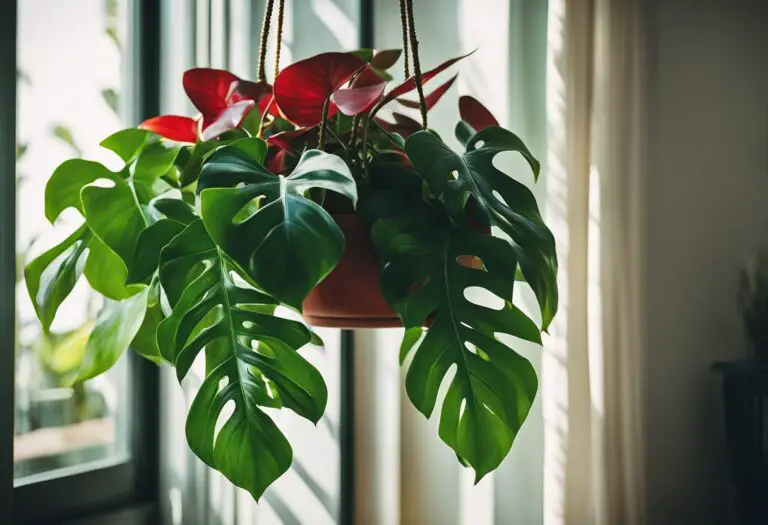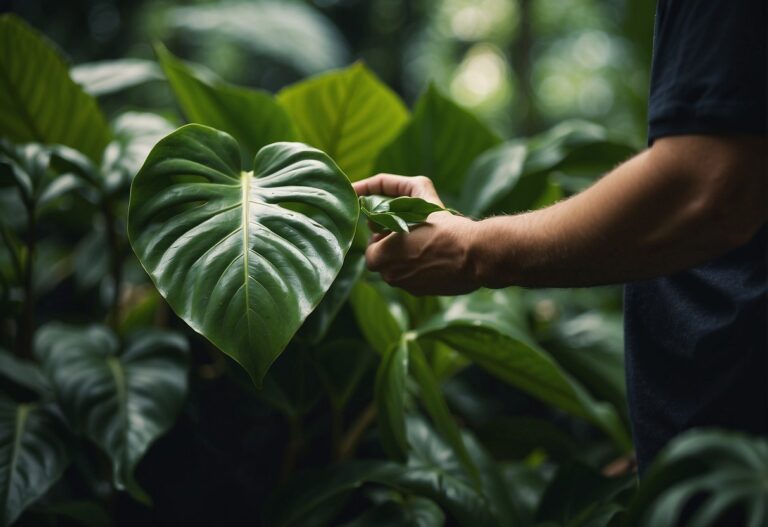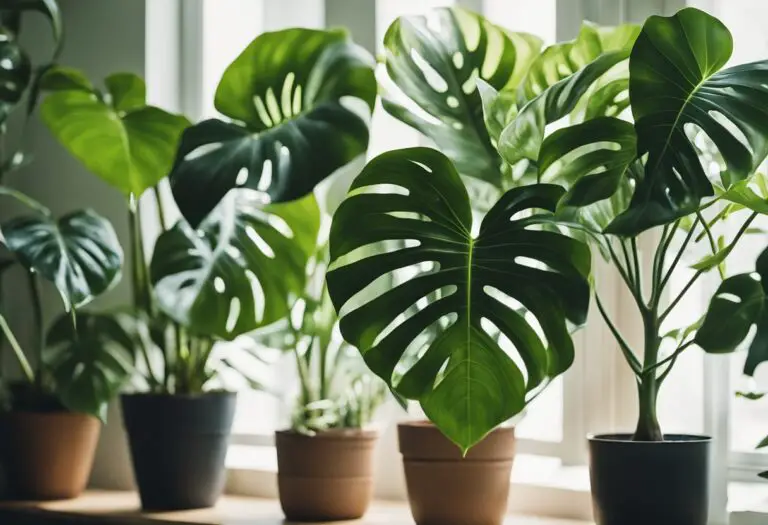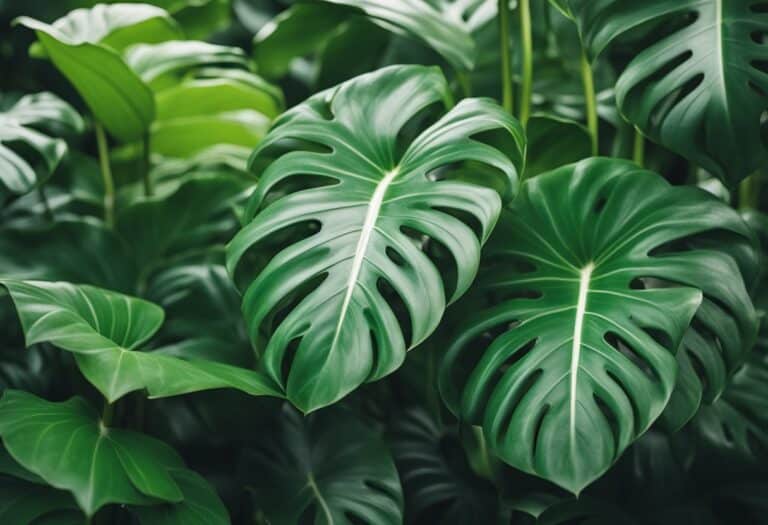Alocasia Pink Princess: A Stunning Houseplant with Pink Leaves
If you’re a plant enthusiast, you’ve probably heard of the Alocasia Pink Princess. This stunning tropical plant is known for its large arrowhead-shaped leaves with striking pink variegation.
Native to Southeast Asia and Australia, the Pink Princess belongs to the Araceae family and grows naturally underneath tree canopies in the tropical forest.

The Pink Princess is a cultivar of Alocasia hybrid, which means it’s a result of crossbreeding different Alocasia species. Although the exact origins of the Pink Princess are unknown, it’s believed to have originated in Thailand. With its unique and eye-catching appearance, the Pink Princess has quickly become a popular houseplant among plant collectors and enthusiasts.
Key Takeaways
- The Alocasia Pink Princess is a stunning tropical plant known for its large arrowhead-shaped leaves with striking pink variegation.
- The Pink Princess is a cultivar of Alocasia hybrid and is believed to have originated in Thailand.
- This unique and eye-catching plant has quickly become a popular houseplant among plant collectors and enthusiasts.
Unveiling the Alocasia Pink Princess

If you’re looking for a unique and stunning houseplant, the Alocasia Pink Princess is a great choice. This plant has broad arrow-shaped leaves that can grow up to 20 inches large. The leaves have a decorative touch, including silver markings and deep veins, and the underside has an elegant burgundy color. Each leaf grows separately per stem.
When it comes to caring for the Alocasia Pink Princess, there are a few things to keep in mind. This plant likes high humidity levels between 60-80% [1], so you may need to use a humidifier or mist the leaves regularly. It also prefers well-draining soil, so be sure to choose a pot with drainage holes at the bottom and fill it with loose, well-drained soil [2].
In terms of lighting, the Alocasia Pink Princess prefers bright, indirect light. Direct sunlight can scorch the leaves, while too little light can cause the plant to become leggy and lose its color. Ideally, the temperature should be between 60-85°F (15-29°C) [1]. Temperatures below 60°F (15°C) can damage the plant, and temperatures above 85°F (29°C) can cause the plant to become stressed and lose its color.
Overall, the Alocasia Pink Princess is a beautiful and unique addition to any plant collection. With a little bit of care and attention, you can enjoy this stunning plant for years to come.
Optimal Growing Conditions

Growing Alocasia Pink Princess can be a bit challenging, but it’s worth the effort. Proper growing conditions are essential to ensure the plant thrives and produces healthy foliage. Here are the optimal growing conditions for your Alocasia Pink Princess.
Light Requirements
Alocasia Pink Princess prefers bright indirect light. Direct sunlight can burn its delicate leaves. If the plant doesn’t receive enough light, it may not produce healthy foliage. Place your plant near a bright window, but avoid direct sunlight.
Watering Schedule
Alocasia Pink Princess requires consistent moisture, but overwatering can cause root rot. Water your plant once a week and ensure the soil is moist but not waterlogged. Use a well-draining potting mix, and ensure the pot has drainage holes.
Temperature and Humidity
Alocasia Pink Princess prefers warm temperatures between 60-85°F (15-29°C). Temperatures below 60°F (15°C) can damage the plant, and temperatures above 85°F (29°C) can cause the plant to become stressed and lose its color. The plant also requires high humidity levels. You can increase humidity by placing a humidifier near the plant or placing a tray of water near the plant.
Soil and Fertilization
Alocasia Pink Princess requires well-draining soil that retains moisture. Use a potting mix that contains peat moss, perlite, and vermiculite. Fertilize your plant once a month during the growing season (spring and summer) using a balanced fertilizer. Avoid fertilizing during the winter months.
Remember, providing optimal growing conditions is essential for your Alocasia Pink Princess to thrive. With proper care, you can enjoy healthy foliage and beautiful pink variegation.
Propagation Techniques
If you want to grow more Alocasia Pink Princess plants, you can propagate them through division or stem cuttings.
Division
Dividing an Alocasia Pink Princess is a simple way to propagate it. You can do it when the plant is already mature enough and has produced several tubers. Here are the steps:
- Carefully remove the plant from its pot.
- Gently shake off the soil from the roots.
- Use a clean and sharp knife to cut the tubers. Make sure that each tuber has roots and at least one healthy leaf.
- Plant each tuber in a separate pot with well-draining soil.
Stem Cuttings
You can also propagate Alocasia Pink Princess through stem cuttings. This method is best done during the growing season when the plant is actively producing new growth. Here are the steps:
- Choose a healthy stem with at least one leaf.
- Using a clean and sharp knife, cut the stem at a 45-degree angle.
- Dip the cut end in rooting hormone powder.
- Plant the stem cutting in a pot with well-draining soil.
- Keep the soil moist and place the pot in a warm and bright spot, but not in direct sunlight.
- After a few weeks, the stem cutting should start to produce roots and new growth.
Remember to be patient when propagating Alocasia Pink Princess. It may take some time before you see any results, but with proper care and attention, you can successfully propagate this beautiful plant.
Common Pests and Diseases
Alocasia Pink Princess is a beautiful plant that can add a touch of royalty to any outdoor space. However, like all plants, it can be susceptible to pests and diseases. Here are some common pests and diseases that you should be aware of when growing Alocasia Pink Princess.
Identifying Common Pests
Aphids are one of the most common pests that can affect Alocasia Pink Princess. These small, pear-shaped insects can be green, black, brown, or even pink, and are usually found clustered on the undersides of leaves or in new growth areas. Aphids can cause stunted growth, yellowing leaves, and distorted foliage on Pink Princess plants.
Mealybugs are another common pest that can affect Alocasia Pink Princess. These insects leave waxy threads and honeydew on the pretty leaves of your plant. They will feast on its sap, so delaying treatment is putting it at risk. As soon as they appear, spray an insecticide on the affected parts, preferably organic.
Disease Prevention and Treatment
Preventing diseases in Alocasia Pink Princess is crucial for its growth and health. Common diseases affecting this plant include crown, stem, and root rot, powdery mildew, leaf spot, and Xanthomonas infection, which can lead to yellowing leaves, brown spots, and wilting.
To prevent these diseases, make sure your plant is not overwatered and has proper drainage. Also, avoid getting water on the leaves, as this can create a humid environment that encourages the growth of fungal diseases. If you notice any signs of disease, such as yellowing leaves or brown spots, remove the affected leaves and treat the plant with a fungicide.
Remember that prevention is the best medicine, so be sure to keep your Alocasia Pink Princess healthy and happy by providing it with the right conditions and care.
Alocasia Pink Princess Care Tips
Taking care of your Alocasia Pink Princess is essential to ensure it remains healthy and vibrant. Here are some care tips to help you keep your plant in tip-top condition.
Pruning and Maintenance
Regular pruning and maintenance are crucial for the growth and health of your Alocasia Pink Princess. To keep your plant looking its best, remove any dead or damaged leaves as soon as possible. This will help prevent the spread of disease and promote new growth.
You can also trim back any overgrown stems to encourage branching and create a fuller plant. When pruning, use a sharp, clean pair of scissors or shears to avoid damaging the plant.
Repotting Guidelines
Alocasia Pink Princess is a fast-growing plant that will quickly outgrow its pot. To keep your plant healthy and thriving, it’s important to repot it every year or two.
When repotting, choose a pot that is one size larger than the current one. Make sure the new pot has drainage holes to prevent waterlogging. Use a well-draining soil mix that contains peat moss and organic compost to ensure optimal root health.
Gently remove the plant from its current pot and carefully separate any tangled roots. Place the plant in the new pot and add soil around the roots, making sure to firmly pack it down. Water the plant thoroughly and place it in a bright, indirect light.
Remember to follow these Alocasia Pink Princess care tips to keep your plant healthy and looking its best.
Frequently Asked Questions
How do you care for an Alocasia Pink Princess?
To care for an Alocasia Pink Princess, you should place it in a bright, indirect light and keep the soil moist but not waterlogged. Make sure the pot has drainage holes and use a well-draining soil mix. You can also fertilize it once a month during the growing season with a balanced fertilizer.
What are the differences between Alocasia Pink Princess and Pink Dragon?
Alocasia Pink Princess and Pink Dragon are two different varieties of Alocasia plants. The Pink Princess has broad arrow-shaped leaves with silver markings and deep veins, while the Pink Dragon has narrow, lance-shaped leaves with pink veins. The Pink Princess also tends to be more expensive and harder to find than the Pink Dragon.
What is the best way to propagate Alocasia Pink Princess?
The best way to propagate an Alocasia Pink Princess is through division. Wait until the plant has grown large enough to have multiple stems, then gently remove it from the pot and separate the stems. Make sure each stem has some roots attached and replant them in separate pots.
How tall can an Alocasia Pink Princess grow?
An Alocasia Pink Princess can grow up to 3 feet tall and 2 feet wide, depending on the growing conditions and care it receives.
Are Alocasia Pink Princess plants considered toxic to pets or humans?
Yes, Alocasia Pink Princess plants are considered toxic to both pets and humans. The plant contains calcium oxalate crystals that can cause irritation and swelling in the mouth and throat if ingested. Keep the plant out of reach of children and pets.
Why might someone find Alocasia plants challenging to grow?
Alocasia plants can be challenging to grow because they require high humidity, warm temperatures, and consistent moisture. They are also prone to root rot if overwatered or planted in soil that doesn’t drain well. Additionally, they may go dormant during the winter months, which can be alarming to new plant owners.






